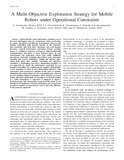| dc.contributor.author | Amanatiadis, Angelos A. | |
| dc.contributor.author | Chatzichristofis, Savvas A. | |
| dc.contributor.author | Charalampous, Konstantinos | |
| dc.contributor.author | Doitsidis, Lefteris | |
| dc.contributor.author | Kosmatopoulos, Elias B. | |
| dc.contributor.author | Tsalides, Phillipos | |
| dc.contributor.author | Gasterato, Antonios | |
| dc.contributor.author | Roumeliotis, Stergios I. | |
| dc.date.accessioned | 2017-10-24T12:24:53Z | |
| dc.date.available | 2017-10-24T12:24:53Z | |
| dc.date.issued | 2013 | |
| dc.identifier.issn | 2169-3536 | |
| dc.identifier.uri | http://hdl.handle.net/11728/10152 | |
| dc.description.abstract | Multi-objective robot exploration constitutes one of the most challenging tasks for autonomous robots performing in various operations and different environments. However, the optimal exploration path depends heavily on the objectives and constraints that both these operations and environments introduce. Typical environment constraints include partially known or completely unknown workspaces, limitedbandwidth communications, and sparse or dense clattered spaces. In such environments, the exploration robots must satisfy additional operational constraints, including time-critical goals, kinematic modeling, and resource limitations. Finding the optimal exploration path under these multiple constraints and objectives constitutes a challenging non-convex optimization problem. In our approach, we model the environment constraints in cost functions and utilize the cognitive-based adaptive optimization algorithm to meet timecritical objectives. The exploration path produced is optimal in the sense of globally minimizing the required time as well as maximizing the explored area of a partially unknown workspace. Since obstacles are sensed during operation, initial paths are possible to be blocked leading to a robot entrapment. A supervisor is triggered to signal a blocked passage and subsequently escape from the basin of cost function local minimum. Extensive simulations and comparisons in typical scenarios are presented to show the efficiency of the proposed approach. | en_UK |
| dc.language.iso | en | en_UK |
| dc.publisher | IEEE | en_UK |
| dc.relation.ispartofseries | IEEE Access;vol.1 | |
| dc.rights.uri | http://creativecommons.org/licenses/by-nc-nd/4.0/ | en_UK |
| dc.subject | Autonomous agents | en_UK |
| dc.subject | Cognitive robotics | en_UK |
| dc.subject | Optimization methods | en_UK |
| dc.subject | Path planning | en_UK |
| dc.title | A Multi-Objective Exploration Strategy for Mobile Robots Under Operational Constraints | en_UK |
| dc.type | Article | en_UK |
| dc.doi | 10.1109/ACCESS.2013.2283031 | en_UK |


